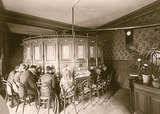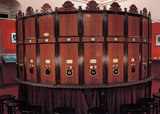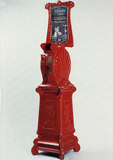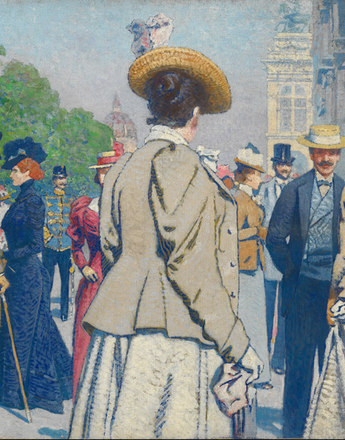Projection shows – precursors of the cinema
-

Imperial Panorama, historical photo, around 1900
Copyright: Filmarchiv Austria
Partner: Filmarchiv Austria -

Kaiserpanorama, photograph
Copyright: Filmarchiv Austria
Partner: Filmarchiv Austria -

Mutoscope (device for presenting moving images), photograph
Copyright: Filmarchiv Austria
Partner: Filmarchiv Austria
Even before the cinematograph conquered the world, showmen presented colourful and spectacular pictures to the public. Attracted by the fascinating moving pictures, audiences immersed themselves in this new sensory experience and forerunner of the visual cinema.
In the pre-cinematographic era, travelling showmen went from place to place, fair to fair, offering projections in the form of cinema obscura, magic lanterns, fantasy peepshows, strange zoetropes and breath-taking panoramas. Clever picture machines deceived the human eye to produce unusual visual impressions. With the ‘laterna magica’, which had already been shown in 1665 in Lyon, Paris, Copenhagen and Rome, pictures and photographs could be enlarged and projected by means of a light beam and convex mirror. Panoramas offered audiences access to an artificially created world. These huge pictures were shown in special buildings, surrounding the viewer in a 360° circle. The first panorama was exhibited in Vienna in 1801 showing a picture of London. The Mutoscope presented a series of cards rotated on a disc. The automated version of this ‘electric high-speed viewer’ was soon to be found in railway stations and entertainment establishments. They existed in Vienna from 1890.
The most popular pictorial medium around 1900 was the Kaiserpanorama, a round wooden construction, usually with twenty-five viewing stations. These collective peepshows were to be found in practically all major cities in the Monarchy. The viewer would look at a picture for around 30 seconds, and then there would be a ringing sound and the photo carousel would rotate to the next picture. The hand-coloured stereoscopic pictures series from Austria and the rest of the world would be changed every week. Apart from travel pictures and cityscapes, the Kaiserpanorama also had pictures of important events of the time. With its weekly changing programme and pictures, it was an early forerunner of the newsreel and a direct precursor of the cinema. The Vienna Kaiserpanorama opened on Stubenring in 1885 and existed there for almost seventy years.
Translation: Nick Somers
Fölsch, Wiebke K.: Buch Film Kinetiks. Zur Vor- und Frühgeschichte von Daumenkino, Mutoskop & Co, Berlin 2011
Kieninger, Ernst/Rauschgatt, Doris: Die Mobilisierung des Blicks. Eine Ausstellung zur Vor- und Frühgeschichte des Kinos, Wien 1995
-
Chapters
- Projection shows – precursors of the cinema
- The first cinematograph in Vienna – a medium takes Austria-Hungary by storm
- From travelling show to cinema
- Roll up! Performances, attractions, shows and sound experiences
- ‘Numbers’ – jewels from all over the world
- From ‘view’ to narration: genres and stars
- Austrian film pioneers



